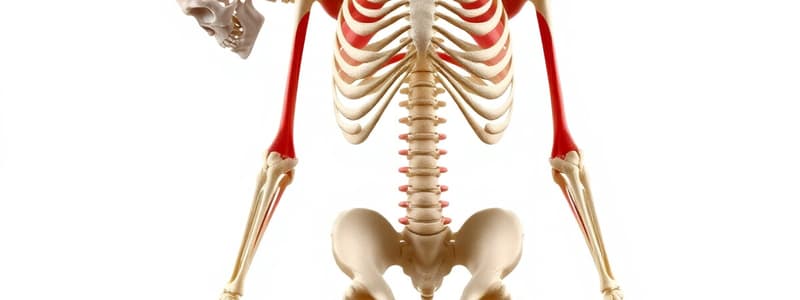Podcast
Questions and Answers
What type of muscle tissue is found in the heart?
What type of muscle tissue is found in the heart?
- Smooth muscle
- Skeletal muscle
- Cardiac muscle (correct)
- Adipose muscle
Which type of joint allows for the widest range of motion?
Which type of joint allows for the widest range of motion?
- Hinge joint
- Ball-and-socket joint (correct)
- Pivot joint
- Fixed joint
Which condition is characterized by inflammation of joints, leading to pain and stiffness?
Which condition is characterized by inflammation of joints, leading to pain and stiffness?
- Osteoporosis
- Muscular Dystrophy
- Arthritis (correct)
- Fractures
What do ligaments connect?
What do ligaments connect?
What is the primary function of tendons?
What is the primary function of tendons?
What type of bone is the femur classified as?
What type of bone is the femur classified as?
Which of the following bones is an example of a flat bone?
Which of the following bones is an example of a flat bone?
What is the porous inner layer of bone that contains bone marrow called?
What is the porous inner layer of bone that contains bone marrow called?
What does the periosteum cover?
What does the periosteum cover?
Which mineral is primarily stored in bones?
Which mineral is primarily stored in bones?
Flashcards are hidden until you start studying
Study Notes
Musculoskeletal System
Overview
- Comprises muscles, bones, cartilage, ligaments, and tendons.
- Provides structure, support, and movement for the body.
- Protects vital organs and stores minerals.
Bones
- Types of Bones
- Long bones (e.g., femur)
- Short bones (e.g., carpals)
- Flat bones (e.g., skull)
- Irregular bones (e.g., vertebrae)
- Bone Structure
- Compact bone: dense outer layer.
- Spongy bone: porous inner layer containing bone marrow.
- Periosteum: fibrous membrane covering bone.
Joints
- Points where two or more bones meet.
- Types of Joints
- Hinge joints (e.g., elbow)
- Ball-and-socket joints (e.g., shoulder)
- Pivot joints (e.g., neck)
- Fixed joints (e.g., skull sutures)
Muscles
- Types of Muscle Tissue
- Skeletal muscle: voluntary, striated, attached to bones.
- Cardiac muscle: involuntary, striated, found in heart.
- Smooth muscle: involuntary, non-striated, found in organs.
- Muscle Contraction
- Involves sliding filament theory (actin and myosin interaction).
- Requires ATP for energy.
Ligaments and Tendons
- Ligaments
- Connect bone to bone.
- Provide stability to joints.
- Tendons
- Connect muscle to bone.
- Transfer forces from muscles to bones for movement.
Functions
- Support
- Provides a framework for the body.
- Movement
- Facilitates movement through contraction and joint function.
- Protection
- Shields internal organs (e.g., rib cage protects the heart and lungs).
- Mineral Storage
- Stores calcium and phosphorus.
- Hematopoiesis
- Blood cell production occurs in bone marrow.
Common Conditions
- Arthritis
- Inflammation of joints, causing pain and stiffness.
- Osteoporosis
- Decreased bone density, increasing fracture risk.
- Muscular Dystrophy
- Genetic disorders causing muscle weakness and degeneration.
- Fractures
- Break in bone integrity; can be classified as simple or compound.
Overview of the Musculoskeletal System
- Comprises muscles, bones, cartilage, ligaments, and tendons.
- Essential for providing structure, support, movement, and vital organ protection.
- Functions in storing minerals, particularly calcium and phosphorus.
Bones
- Types of Bones
- Long bones, like the femur, support weight and facilitate movement.
- Short bones, such as carpals, provide stability and some flexibility.
- Flat bones, e.g., the skull, protect internal organs and serve as muscle attachment sites.
- Irregular bones, like vertebrae, support and protect the spinal cord.
- Bone Structure
- Compact bone forms a dense outer layer for strength.
- Spongy bone contains a porous inner layer filled with bone marrow for blood cell production.
- Periosteum is a fibrous membrane that covers and nourishes the bone.
Joints
- Joints are points of articulation where two or more bones connect.
- Types of Joints
- Hinge joints, e.g., elbows, allow for bending and straightening.
- Ball-and-socket joints, such as shoulders, enable circular movement and rotation.
- Pivot joints, like those in the neck, allow rotational movement.
- Fixed joints, such as skull sutures, do not permit movement.
Muscles
- Types of Muscle Tissue
- Skeletal muscle is voluntary and striated, attached to bones for movement.
- Cardiac muscle is involuntary and striated, specifically found in the heart.
- Smooth muscle is involuntary and non-striated, located in internal organs.
- Muscle Contraction
- Sliding filament theory describes how actin and myosin interact during contraction.
- Muscle contraction requires ATP (adenosine triphosphate) as an energy source.
Ligaments and Tendons
- Ligaments
- Connect one bone to another, providing joint stability.
- Tendons
- Connect muscles to bones, facilitating force transfer for movement.
Functions of the Musculoskeletal System
- Support
- Provides a rigid framework that shapes the body.
- Movement
- Enables movement through muscle contraction and joint function.
- Protection
- Protects internal organs, e.g., rib cage safeguards the heart and lungs.
- Mineral Storage
- Acts as a reservoir for minerals, primarily calcium and phosphorus.
- Hematopoiesis
- Blood cell production occurs in the bone marrow, essential for maintaining blood health.
Common Conditions
- Arthritis
- Inflammation of joints leads to pain, stiffness, and decreased mobility.
- Osteoporosis
- Characterized by reduced bone density, increasing susceptibility to fractures.
- Muscular Dystrophy
- Genetic disorders result in progressive muscle weakness and degeneration.
- Fractures
- Breaks in bone integrity categorized as simple (closed) or compound (open).
Studying That Suits You
Use AI to generate personalized quizzes and flashcards to suit your learning preferences.




